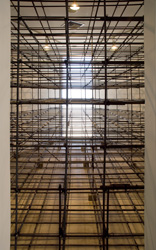Ruben Ochoa, If I had a rebar for every time someone tried to mold me, 2007.
Born 1974 in Oceanside, California; lives in Los Angeles, California
Ruben Ochoa’s monumental use of building materials in sculpture, photography, and public interventions deconstructs a constructionworker aesthetic by investigating urban locations under contention. Cataloguing places of social and economic transactions as sites for documentation or site-specific installations, he presents a finely tuned vision of Los Angeles as a city socially, economically, and geographically described by its freeways and street curbs. Beyond its formal references to civil engineering, Ochoa’s work critiques class boundaries determined by these borders in his rejection of traditionally exclusionary exhibition styles. Relocating industrial or outdoor materials such as cement, rebar, pallets, and dirt into the gallery and displaying artworks in unlikely areas throughout the city, he juxtaposes refinement with grit, as did Walter De Maria and environmental sculptors like Edward Kienholz. Increasingly Ochoa studies areas where nature buttresses itself against annihilation, a cultural metaphor lending hope and vivacity to his work.
Ochoa’s conceptual arguments extend into large socioeconomic arenas. For several years he installed other artists’ works in his mobile exhibition space, CLASS: C (2001–05), converted from his family’s tortilla delivery van. One part of three in his 2006 show at Los Angeles’s LAXART, Extracted (2006) filled the gallery with what appeared to be a massive concrete slab heaped with dirt; intrepid viewers discovered that the installation was chicken wire thinly covered with soil and cement. A disruptive reminder of the raw chaos outside, this work indicates the artist’s deepening concern with sculpture as architecture and with architecture as a reflection of its surrounding culture. In Fwy Wall Extraction (2006–07) Ochoa applied wallpaper to a section of wall on the Interstate 10 freeway (chosen because it surrounds, separates, and disrupts culturally diverse populations) depicting a photo-realistic cross section of the landscape that might exist behind the cement.
In his 2007 exhibition A Recurring Amalgamation at Susanne Vielmetter Los Angeles Projects, Ochoa explored collisions between the natural and manufactured within the exhibition space, though landscape photographs lining the walls reminded viewers to search for art outside the white cube. In Infracted Expansion (2007) freeway column–tree trunk hybrids were installed atop cement-crusted pallets jutting from the floor like icebergs. A cast-concrete pallet called Lean Back (2007) reclined against one wall. Nearby a suite of chromogenic prints catalogued ficus trees whose roots have defiantly busted through the sidewalk. Nonnative to Los Angeles, here their exuberance might symbolize the city’s immigrant community. Kissed in the 90011 (2007), in which a curb and the ficus growing from it are both colored by the same carelessly applied swath of red paint, harks back to Ochoa’s appreciation of human intervention. In this image the artist’s formal interests seamlessly coincide with unexpected environmental discoveries to unearth art in his urban daily experience. TRINIE DALTON
Ruben Ochoa, If I had a rebar for every time someone tried to mold me, 2007. Rebar, annealed wire ties, and dobie blocks, 122 x 198 x 222 in. (284.5 x 502.9 x 563.9 cm). Collection of the artist. Courtesy Susanne Vielmetter Los Angeles Projects.
























